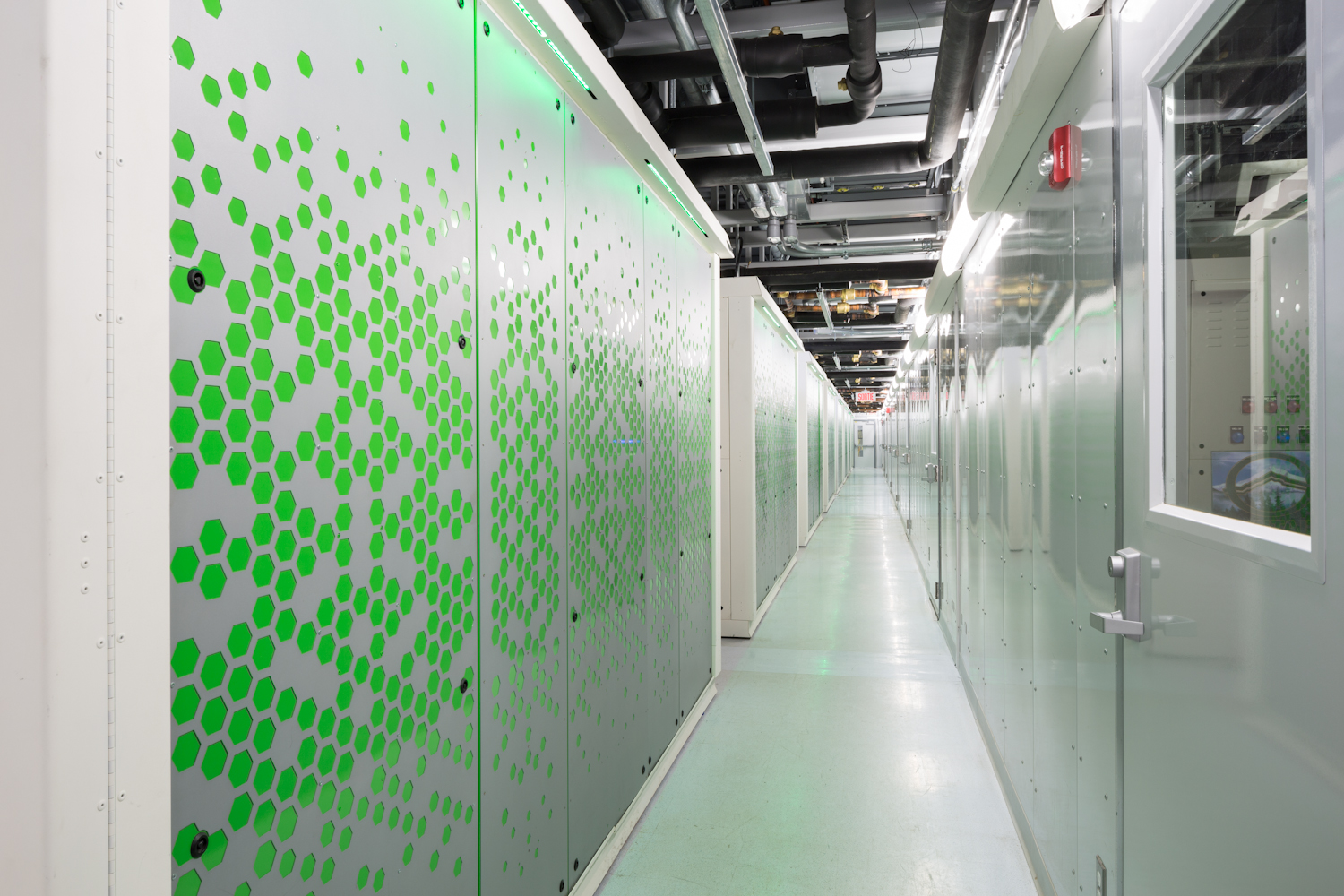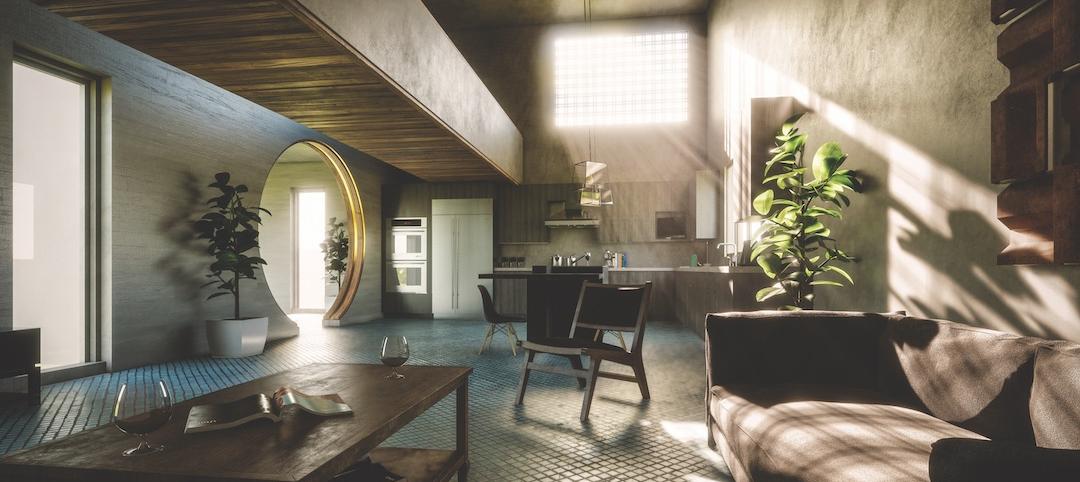If all goes as planned, Canada’s third-largest telecommunications company, Telus, next month will open what has been billed as one of the most energy-efficient data centers in the world. The $75 million, 215,000-sf facility, located in Kamloops, B.C., is projected to use up to 80% less power and 86% less water than a typical data center of its size. Its peak power utilization effectiveness (PUE)—the ratio of total energy used by the data center to the energy delivered to the computing equipment—is estimated at a minuscule 1.15.
The “secret sauce,” according to the facility’s contractor, Skanska, is a patented cooling technology, called eOPTI-TRAX, that replaces the traditional chiller plant. Together with its modular data center partner, Inertech, Skanska supplied the distributed, closed-loop system, which greatly expands the temperature range at which a facility can utilize outdoor air for “free” cooling. Telus’ Kamloops Internet Data Centre, for instance, will be able to use 100% outside air for cooling when temperatures are as high as 85°F—a huge improvement over the 45°F threshold typical with traditional chiller plant setups.
In lieu of underfloor air distribution, which requires numerous fans to push cold air toward the racks to cool the servers, the eOPTI-TRAX approach uses a contained hot- and cold-aisle design with optimized air circulation in the server aisles and liquid refrigerant coils lining the inside of the rear walls of the server rack to draw and absorb the heat. The scheme reduces hot-aisle temperatures from 160°F to just 75°F, according to Skanska.
The Telus project is among a handful of recently completed data centers that are raising the bar for energy and water efficiency. Building Teams are employing a range of creative solutions—from evaporative cooling to novel hot/cold-aisle configurations to heat recovery schemes—in an effort to slash energy and water demand. In addition, a growing number of data center developers are building facilities in cool, dry locations to take advantage of 100% outdoor air for cooling.
The National Center for Atmospheric Research’s new $70 million, 153,000-sf Wyoming Supercomputing Center in Cheyenne, for instance, uses the cool, dry air in combination with evaporative cooling towers to chill the supercomputers 96% of the year. Even when factoring the facility’s administrative offices, the building’s ultimate PUE is projected to be 1.10 or less, placing it in the top 1% of energy-efficient data centers worldwide. Where possible, the data center reuses waste heat for conditioning the office spaces and for melting snow and ice on the walkways and loading docks. Chilled beams provide efficient cooling in the administrative areas.
Facebook’s new model for data centers
While a temperate climate can be hugely advantageous for data center owners, it’s not a requirement for achieving a low PUE and WUE (water usage effectiveness), say data center design experts. Building Teams and technology providers continue to develop schemes that can operate efficiently at higher temperatures and relative humidity levels.
Take Facebook’s data center in Forest City, N.C., for example. Unlike the company’s other data center locations in Prineville, Ore., and Lulea, Sweden, the Forest City facility sits in a warm, humid climate—yet it has been able to achieve a PUE on par with the other installations, at 1.07, according to Daniel Lee, PE, Data Center Design Engineer at Facebook.
“Last summer, we had the second-hottest summer on record in Forest City and we didn’t have to use our DX system (direct expansion coils) system,” says Lee. “Although it was hot, with highs of 103°F, the relative humidity was low enough so that we could use the water (evaporative cooling) to cool the space.”
The trick, says Lee, is a simplified, holistic approach to data center design that optimizes not only the building mechanical systems, but also the computer hardware (servers and racks) and software applications—all with an eye toward reliability and energy efficiency. Traditional mechanical components—UFAD, chillers, cooling towers, etc.—are replaced with a highly efficient evaporative cooling scheme that uses 100% airside economization and hot-aisle containment. An open-rack server setup with exposed motherboards greatly reduces the energy required to cool the equipment. The result is a facility with fewer moving parts to break down that can operate efficiently at interior temperatures in excess of 85°F.
Facebook made waves in 2011 when it made public its design specs for its first in-house data center, in Prineville, under a program called the Open Compute Project. Modeled after open-source software communities, the program relies on crowd sourcing to share and improve on Facebook’s base data center scheme.
“We give the design away; you can take it and build it yourself,” says Chuck Goolsbee, Datacenter Site Manager at Facebook’s Prineville location. “All the components are there to build it in sort of a LEGO-like manner, from the building itself down to the servers.”
Facebook expects big things from the Open Compute Project. Many of the core component suppliers are involved—including Dell, Hewlett-Packard, Intel, and AMD—and thousands of data center experts have participated in engineering workshops and have given feedback to the group.
“Fifteen years from now, the DNA from Open Compute will be in every data center in the world,” says Goolsbee.
Related Stories
BIM and Information Technology | Jul 9, 2018
Healthcare and the reality of artificial intelligence
Regardless of improved accuracy gains, caregivers may struggle with the idea of a computer logic qualifying decisions that have for decades relied heavily on instinct and medical intuition.
BIM and Information Technology | Jul 2, 2018
Data, Dynamo, and design iteration
We’re well into the digital era of architecture which favors processes that have a better innovation cycle.
Accelerate Live! | Jun 24, 2018
Watch all 19 Accelerate Live! talks on demand
BD+C’s second annual Accelerate Live! AEC innovation conference (May 10, 2018, Chicago) featured talks on AI for construction scheduling, regenerative design, the micro-buildings movement, post-occupancy evaluation, predictive visual data analytics, digital fabrication, and more. Take in all 19 talks on demand.
BIM and Information Technology | Jun 12, 2018
Machine learning takes on college dropouts
Many schools use predictive analytics to help reduce freshman attrition rates.
| Jun 11, 2018
Accelerate Live! talk: The smart jobsite — Predictive visual data analytics for proactive project controls
In this 15-minute talk at BD+C’s Accelerate Live! conference (May 10, 2018, Chicago), a trio of experts in predictive visual data analytics presents how design-build giant Clayco has leveraged this technology to achieve production efficiency on several construction sites.
| Jun 11, 2018
Accelerate Live! talk: ‘AEC can has Blockchains?’
In this 15-minute talk at BD+C’s Accelerate Live! conference (May 10, 2018, Chicago), HOK’s Greg Schleusner explores how the AEC industry could adapt the best ideas from other industries (banking, manufacturing, tech) to modernize inefficient design and construction processes.
| May 30, 2018
Accelerate Live! talk: Seven technologies that restore glory to the master builder
In this 15-minute talk at BD+C’s Accelerate Live! conference (May 10, 2018, Chicago), AEC technophile Rohit Arora outlines emerging innovations that are poised to transform how we design and build structures in the near future.
| May 30, 2018
Accelerate Live! talk: Why the AEC industry must adapt to the Internet of Things boom
In this 15-minute talk at BD+C’s Accelerate Live! conference (May 10, 2018, Chicago), building systems expert Jeff Carpenter explores established and emerging IoT applications for commercial and institutional buildings, and offers a technology roadmap for navigating the IoT landscape.
Sponsored | | May 24, 2018
Water treatment facility renovation benefits from laser scanning technology
BIM and Information Technology | Apr 5, 2018
Tech Report 5.0: Why wait for 3D renderings?
With emerging real-time rendering tools, project teams can design and render on the fly, for enhanced collaboration and resource savings. But the software comes with a catch.












